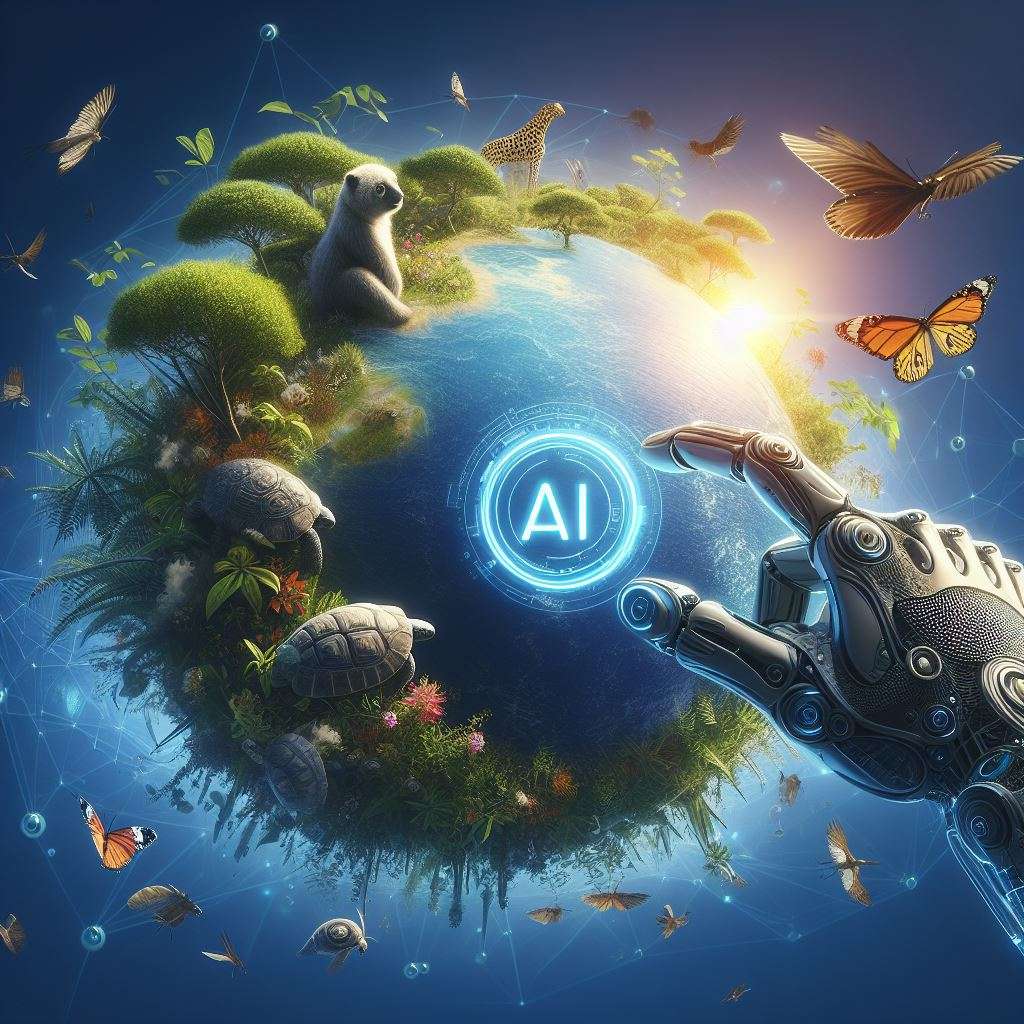Introduction

In an era marred by environmental challenges, Artificial Intelligence (AI) emerges as a beacon of hope in the realm of ecological preservation. The integration of AI technologies presents unparalleled opportunities to address pressing environmental issues. From optimizing resource management to enhancing environmental monitoring and disaster mitigation, AI’s transformative potential holds promise for fostering sustainable practices. By leveraging advanced algorithms, predictive models, and innovative applications, AI offers solutions to conserve biodiversity, mitigate climate change impacts, and protect ecosystems. However, its ethical deployment and collaborative utilization remain imperative in ensuring its positive impact on environmental sustainability.
AI-Powered Resource Management
In the pursuit of sustainable living and ecological preservation, the effective management of resources stands as a critical focal point. Artificial Intelligence (AI) has emerged as a transformative force in this arena, offering unparalleled capabilities in analyzing vast and intricate datasets to optimize resource consumption across various sectors.
1. Optimizing Resource Usage: AI’s prowess lies in its ability to process and interpret colossal amounts of data, enabling precise insights into resource consumption patterns. This capability facilitates the identification of inefficiencies and opportunities for improvement in diverse domains such as energy, water, and waste management.
2. Energy Management: Within the realm of energy, AI-driven systems are revolutionizing traditional grids through the implementation of smart grids. These grids intelligently regulate energy flow, optimizing distribution and consumption while incorporating renewable energy sources. AI algorithms predict energy demands, thereby enhancing efficiency and reducing overall consumption.
3. Water Conservation: AI’s application extends to agriculture, where precision irrigation systems utilize data analytics to tailor water usage according to specific crop needs. By analyzing soil moisture, weather forecasts, and plant requirements, AI-driven irrigation minimizes water wastage and ensures optimal crop growth, contributing to sustainable farming practices.
4. Waste Reduction and Management: Waste management strategies benefit significantly from AI-powered analytics. Smart waste management systems employ sensors and data analysis to optimize collection routes, reduce overflow in landfills, and identify opportunities for recycling. These AI-enabled solutions drive efficient waste processing and resource recovery.
5. Case Studies: Real-world examples demonstrate the efficacy of AI in resource management. Initiatives by industries and municipalities employing AI for optimizing resource usage could include energy-efficient factories, cities employing AI for traffic management to reduce fuel consumption, or waste management systems that minimize environmental impact.
Environmental Monitoring and Analysis
In the quest for ecological preservation, understanding environmental dynamics and changes is imperative. AI-powered environmental monitoring systems have emerged as pivotal tools, offering unprecedented capabilities in tracking, analyzing, and interpreting data related to ecosystems, biodiversity, and environmental shifts.
1. Remote Sensing Technologies:
AI leverages remote sensing technologies such as satellite imagery, drones, and sensor networks to monitor changes in landscapes, ecosystems, and natural habitats. These tools provide a comprehensive view of environmental changes and help track alterations in land use, deforestation rates, and biodiversity.
2. Biodiversity Preservation:
AI algorithms play a crucial role in preserving biodiversity by identifying and tracking endangered species. These systems process vast datasets of species’ behavior, habitat conditions, and population dynamics, aiding conservation efforts by providing valuable insights into species distribution and habitats at risk.
3. Real-Time Monitoring and Analysis:
The real-time capabilities of AI enable constant monitoring and analysis, offering timely responses to environmental changes. This includes tracking phenomena like wildfires, illegal logging, or sudden changes in wildlife populations, facilitating prompt intervention and mitigation strategies.
4. Conservation Initiatives:
Collaborative efforts between AI experts, conservationists, and policymakers have led to innovative conservation initiatives. These initiatives leverage AI-driven data analytics to create informed conservation plans, ensuring the preservation of ecosystems and endangered species.
5. Case Studies and Success Stories:
Numerous success stories showcase the impact of AI in environmental monitoring. For instance, AI-powered systems have been instrumental in monitoring coral reefs’ health, tracking deforestation rates in remote regions, and identifying illegal fishing activities in protected marine areas.
The integration of AI into environmental monitoring heralds a paradigm shift in our ability to comprehend and respond to ecological changes. By providing real-time insights and predictive analyses, AI empowers conservationists and policymakers to make informed decisions crucial for safeguarding our planet’s ecosystems. As we delve further, we will explore AI’s role in climate change mitigation, wildlife protection, and disaster prediction and response—areas where AI continues to make profound strides in ecological preservation.
AI in Climate Change Mitigation
Climate change stands as one of the most pressing global challenges, and AI has emerged as a powerful ally in understanding its complexities and mitigating its adverse effects. The application of AI technologies in climate change mitigation spans various domains, from predictive modeling to fostering sustainable solutions.

1. Predictive Climate Modeling:
AI models analyze historical and real-time data to predict climate patterns, including temperature changes, precipitation, and extreme weather events. These predictive models aid in understanding the evolving climate landscape, enabling better preparedness and mitigation strategies.
2. Renewable Energy and Energy Efficiency:
AI contributes significantly to the development of renewable energy sources and enhances energy efficiency. Through AI-driven systems, renewable energy technologies like solar and wind power can be optimized for maximum output. Additionally, AI algorithms optimize energy usage in industries and households, reducing overall consumption and carbon footprints.
3. Climate Adaptation Strategies:
AI’s predictive capabilities assist in formulating climate adaptation strategies. By analyzing data on changing environmental conditions, AI helps communities and governments prepare for and adapt to the impacts of climate change, such as rising sea levels, extreme weather events, and shifts in agricultural patterns.
4. Carbon Capture and Sequestration:
AI plays a role in improving carbon capture and sequestration technologies. AI-driven systems optimize the efficiency of capturing and storing carbon emissions from industries, aiding in the reduction of greenhouse gas concentrations in the atmosphere.
5. Innovations for Sustainability:
AI fosters the development of innovative technologies that promote sustainability. Smart city initiatives utilize AI to optimize urban infrastructure, reduce energy consumption, and enhance public transportation, contributing to overall climate resilience.
6. Collaborative Efforts and Global Impact:
Collaborations between AI experts, environmental scientists, policymakers, and industries are crucial in implementing AI-driven solutions for climate change mitigation. Such collaborations have the potential to create a global impact by fostering sustainable practices and reducing carbon emissions on a larger scale.
The integration of AI technologies in climate change mitigation signifies a pivotal step towards addressing the challenges posed by a changing climate. By harnessing AI’s predictive capabilities and fostering sustainable innovations, there exists a promising pathway towards a more resilient and sustainable future. In the subsequent sections, we will explore AI’s role in wildlife protection, disaster prediction, and response—areas where AI continues to make significant contributions to ecological preservation and sustainability efforts.
Wildlife Protection and Conservation
The preservation of biodiversity and protection of endangered species are pivotal aspects of ecological conservation. AI-driven technologies play a significant role in monitoring, safeguarding, and supporting conservation efforts aimed at protecting wildlife across the globe.
1. Threat Detection and Monitoring:
AI-powered systems equipped with image recognition and sound analysis capabilities aid in the detection and monitoring of wildlife species. These systems identify and track endangered species, allowing conservationists to monitor their populations and habitats.
2. Anti-Poaching Initiatives:
AI technologies are instrumental in combating illegal activities such as poaching. AI-powered drones, cameras, and sensors help monitor protected areas, detect suspicious activities in real time, and alert authorities to intervene, thereby curbing poaching activities and protecting vulnerable species.
3. Habitat Preservation and Restoration:
AI assists in analyzing vast amounts of ecological data to understand and preserve habitats critical for various species. This includes mapping ecosystems, identifying areas for habitat restoration, and developing strategies to protect these environments.
4. Data-Driven Conservation Strategies:
AI’s data analysis capabilities aid in devising more effective conservation strategies. By processing large datasets related to wildlife behavior, migration patterns, and environmental changes, AI enables the formulation of informed and adaptive conservation plans.
5. Success Stories and Collaborative Efforts:
Numerous success stories highlight the impact of AI in wildlife conservation. Collaborations between conservation organizations, researchers, and AI experts have led to successful initiatives that protect endangered species and restore ecosystems.
6. Challenges and Future Prospects:
While AI presents significant opportunities for wildlife protection, challenges such as data quality, ethical considerations, and the need for international cooperation persist. Future prospects involve refining AI applications, ensuring ethical use, and fostering global collaboration for more extensive wildlife conservation efforts.
Disaster Prediction, Response, and Preparedness
Natural disasters pose significant threats to both human populations and the environment. AI technologies have increasingly been utilized to predict, respond to, and prepare for various natural calamities, thereby mitigating their impacts and enhancing overall disaster management.
1. Predictive Modeling for Early Warning Systems:
AI algorithms analyze historical data and real-time information to predict natural disasters such as hurricanes, floods, earthquakes, and wildfires. These predictive models contribute to developing early warning systems, providing crucial time for evacuation and preparation.
2. Real-Time Monitoring and Response:
AI-enabled monitoring systems offer real-time insights into changing environmental conditions during disasters. Drones, satellites, and sensors equipped with AI can swiftly assess the extent of damage, aid in search and rescue operations, and support emergency response efforts.
3. Improving Resilience and Preparedness:
AI assists in improving disaster resilience by simulating disaster scenarios and enabling better planning and preparedness strategies. This includes optimizing evacuation routes, predicting resource needs, and coordinating response efforts more efficiently.
4. Humanitarian Aid and Crisis Management:
AI-driven technologies facilitate humanitarian aid during and after disasters. Chatbots, data analysis tools, and predictive models aid in managing crises, coordinating relief efforts, and assessing the needs of affected communities.
5. Success Stories and Ongoing Research:
Several success stories demonstrate the efficacy of AI in disaster management. Ongoing research focuses on refining AI models, enhancing data accuracy, and developing more robust systems for early warning and rapid response.
6. Challenges and Ethical Considerations:
Despite its potential, AI in disaster management encounters challenges such as data accessibility, algorithm biases, and ethical dilemmas. Addressing these challenges involves ensuring equitable access to technology, mitigating biases, and upholding ethical standards in AI deployment during crises.
The integration of AI in disaster prediction, response, and preparedness signifies a significant advancement in safeguarding lives, minimizing damage to the environment, and enhancing the efficiency of emergency response systems. As AI continues to evolve, further advancements in disaster management hold promise for more resilient and effective responses to natural disasters.
Challenges and Ethical Considerations in AI for Ecology
While AI holds immense potential for ecological preservation, its implementation presents several challenges and ethical considerations that require careful attention and resolution.
1. Data Quality and Accessibility:
– Challenge: Availability and quality of data for training AI models can be limited or biased, affecting the accuracy and fairness of AI applications.
– Resolution: Efforts to ensure diverse and high-quality datasets, along with transparency regarding data sources and collection methods, are crucial. Collaboration between stakeholders to improve data accessibility and accuracy is essential.
2. Algorithmic Bias and Fairness:
– Challenge: AI systems may inherit biases present in the data used for training, leading to unfair outcomes or decisions that disproportionately impact certain communities or ecosystems.
– Resolution: Ethical design principles and ongoing monitoring of AI algorithms are essential to detect and mitigate biases. Diversity in AI development teams and inclusive approaches to model training can help address biases.
3. Environmental Impact of AI Infrastructure:
– Challenge: The computational demands of AI, including data centers and hardware, contribute to energy consumption and environmental impact.
– Resolution: Implementing energy-efficient AI algorithms and promoting renewable energy sources for AI infrastructure can help reduce its environmental footprint.
4. Ethical Use of AI in Conservation and Wildlife Monitoring:
– Challenge: Privacy concerns related to the monitoring of wildlife and habitats through AI-powered systems, potentially disturbing ecosystems or infringing upon animal rights.
– Resolution: Establishing ethical guidelines for wildlife monitoring, respecting privacy rights, and minimizing disruptions to natural habitats are crucial aspects of responsible AI deployment in conservation.
5. Regulation and Policy Frameworks:
– Challenge: Lack of comprehensive regulations and ethical guidelines for AI applications in ecology and environmental preservation.
– Resolution: Governments and international bodies should collaborate to establish clear policies and ethical frameworks guiding the development and deployment of AI in ecological conservation.
Addressing these challenges and ethical considerations is fundamental to harnessing the full potential of AI in preserving ecology while ensuring responsible and sustainable use of these technologies. Continued research, collaboration among stakeholders, and ethical considerations must remain at the forefront of AI development for ecological preservation.
Future Prospects and Collaborative Initiatives
The future of AI in ecological preservation holds immense promise, offering opportunities for innovative solutions and collaborative efforts aimed at achieving sustainability and biodiversity conservation.
1. Advancements in AI Technology:
– Continued advancements in AI algorithms, including machine learning, deep learning, and reinforcement learning, will enhance the accuracy and efficiency of ecological preservation applications.
– Integration of AI with other emerging technologies like IoT (Internet of Things), blockchain, and quantum computing could further revolutionize environmental monitoring and resource management.
2. Interdisciplinary Collaboration:
– Collaborative efforts between scientists, conservationists, policymakers, AI experts, and technology developers are crucial. Cross-disciplinary collaborations foster diverse perspectives and innovative solutions for ecological challenges.
3. Citizen Science and Community Engagement:
– Involving communities and promoting citizen science initiatives empowers individuals to contribute to ecological preservation efforts. AI-driven platforms can facilitate citizen engagement, data collection, and collaborative problem-solving.
4. Global Partnerships for Sustainability:
– International partnerships and alliances are essential for global-scale initiatives addressing climate change, biodiversity loss, and environmental conservation. Collaborations among countries and organizations amplify the impact of AI-driven solutions.
5. Ethical AI and Responsible Innovation:
– Emphasizing ethical AI practices, transparency, and accountability in AI development and deployment is crucial. Ensuring that AI technologies align with ethical standards and prioritize sustainability remains paramount.
6. Education and Awareness:
– Promoting education and awareness about the role of AI in ecological preservation fosters understanding and support for sustainable practices. Educating the public about AI’s potential and limitations encourages responsible use and participation.
The future landscape of AI in ecology hinges on collaborative endeavors, technological advancements, and ethical considerations. By embracing innovation while upholding ethical standards and global cooperation, AI is poised to play a pivotal role in preserving the environment and ensuring a sustainable future for future generations.
Conclusion
In conclusion, AI stands as a transformative force in ecological preservation, revolutionizing resource management, environmental monitoring, and disaster response. Its potential, coupled with ethical considerations and collaborative efforts, offers a beacon of hope for sustainable solutions in safeguarding our planet’s ecosystems.
